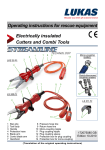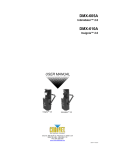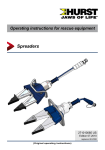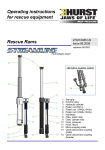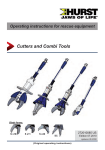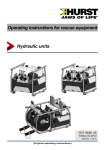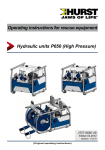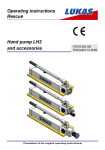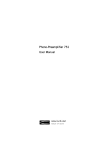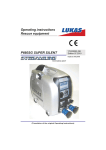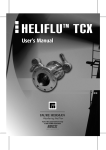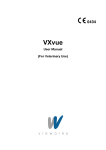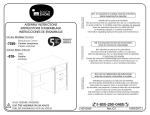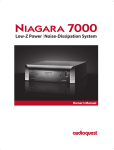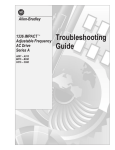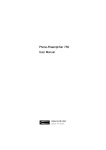Download - Hurst Jaws Of Life
Transcript
Operating instructions for rescue equipment Cutter 159R195 US Edition 03.2012 (Original operating instructions) Content Page 1. Hazard classes 4 2. Product safety 5 3. Intended use 8 4. Description of the functions 9 4.1Description 9 4.2 Tool in detail 9 4.3 Circuit diagram 10 4.4 Control of the operating movements 10 4.5 Hydraulic supply 10 4.6Hoses 10 5. Connecting the equipment 11 5.1 General information 11 5.2 Coupling the mono-couplings 11 5.3 Coupling the quick-disconnect couplings 12 6.Operation 12 6.1Preparations 13 6.2 Operating the star grip 13 7.Cutting 14 7.1 Safety notes 14 7.2Cutting 14 8. Dismantling the equipment / deactivation following operation 15 8.1Cutters 15 8.2 Hydraulic unit 15 8.3Hoses 15 9. Maintenance and service 16 9.1 Cutters, overall 16 9.2 Protective equipment 17 10.Repairs 17 10.1 General information 17 10.2 Preventative service 18 10.3Repairs 19 2 11.Troubleshooting 25 12. Technical Data 27 12.1Cutter 27 12.2 Torque of the pivot bolt 30 12.3 Recommended hydraulic fluid 30 12.4 Operating and storage temperature Ranges 30 12.5Conversions 30 13.Notes 31 3 1. Hazard classes We distinguish between various categories of safety notes. The table below gives you an overview of the assignment of symbols (pictograms) and key words to the specific hazard and possible consequences. Damage / injury to device human Pictogram Key word Definition Consequences DANGER! Immediate danger Death or major injury WARNING! Potentially dangerous situation Potential death or major injury CAUTION! Less dangerous situation Minor or slight injury CAUTION! Danger of damage to device / environment Damage to the equipment, damage to the environment, damage to surrounding materials REMARK Advice for application and other important / useful information and advice No injury / damage to persons / environment / equipment - Wear helmet with face protection Wear safety gloves Wear safety shoes Proper recycling Observe principles of environmental protection Read and observe operating instructions 4 2. Product safety JAWS OF LIFE products are developed and manufactured in order to guarantee the best performance and quality when used properly. Operator safety is the most important aspect of the product design. Moreover, the operating instructions are intended to help the safe use of JAWS OF LIFE products. The generally applicable, legal and other binding regulations pertaining to the prevention of accidents and protection of the environment apply and are to be implemented in addition to the operating instructions. The equipment may only be operated by persons with appropriate training in the safety aspects of such equipment – otherwise, there is a danger of injury occurring. We would like to point out to all users that they should read the operating instructions carefully and the instructions contained therein before they use the equipment, and that they should carefully follow such. We further recommend that a qualified trainer train you in the use of the product. WARNING / CAUTION! The operating instructions for the hoses, the accessories and the connected hydraulic equipment must also be observed! Even if you have already received instructions on how to use the equipment, you should still read the following safety notes through again. WARNING / CAUTION! Ensure that the accessories and connected equipment used are suitable for the max. operating pressure! Please ensure that no body parts or clothing get stuck between the visibly moving parts (e.g. blade arms). Wear protective clothing, safety helmet with visor, protective gloves It is prohibited to work under load if this load is lifted exclusively by hydraulic equipment. If this work is absolutely imperative, additional mechanical supports must be used. Inspect the equipment before and after use for visible defects or damage The responsible department is to be informed immediately of any changes (including to the operating behavior)! If necessary, the equipment is to be deactivated immediately and secured! In the event of malfunctions, immediately deactivate the equipment and secure it. The malfunction is to be repaired immediately. Inspect all cables, hoses and screwed connections for leaks and externally visible damage! If necessary, repair immediately! Squirting hydraulic fluid can result in injuries and fires. Do not carry out any changes (additions or conversions) to the equipment without obtaining the prior approval of HURST. 5 Observe all safety and danger notes on the equipment and in the operating instructions. All safety and danger notes on the equipment are to be kept complete in a legible condition. Any mode of operation which impairs safety and/or stability of the equipment is forbidden! Comply with all specified dates or dates specified in the operating instructions pertaining to regular controls / inspections on the equipment. Safety devices may never be deactivated! The maximum permitted operating pressure noted on the equipment must not be exceeded. Before the equipment is switched on/started up, and during its operation, it must be ensured that nobody will be endangered by the operation of the equipment. Only original HURST accessories and spare parts may be used for repairs. Please ensure that, when working with this equipment or during transportation of such, you don’t get caught in the looped hoses and trip. Please note that, when cutting or spreading, tearing or breaking can cause falling material, or sudden removal of such can cause it to suddenly catapult off: necessary precautions need to be taken. When working close to live components and cables, suitable measures must be taken to avoid current transfers or high-voltage transfers to the equipment. The build-up of static charge with the potential consequence of spark formation is to be avoided when handling the equipment. Only touch any broken-off parts or the cut-off parts wearing protective gloves, since the torn / cut edges can be very sharp. The equipment is filled with a hydraulic fluid. These hydraulic fluids can be dangerous to health if swallowed or their vapors inhaled. Direct contact with the skin is to be avoided for the same reason. Please also note that hydraulic liquids can also have a negative effect on biological systems. Ensure adequate lighting when you are working. When working with or storing the equipment, ensure that the function and the safety of the equipment are not impaired by the effects of stark external temperatures or that the equipment is damaged in any way. Please note that the equipment can also heat up over a long period of use. Before transporting the equipment, always ensure that the accessories are positioned such that they cannot cause an accident. 6 Always keep these operating instructions within reach where the equipment is used. Ensure the proper disposal of all removed parts, left-over oil and hydraulic fluid as well as packaging materials! The generally applicable, legal and other binding national and international regulations pertaining to the prevention of accidents and protection of the environment apply and are to be implemented in addition to the operating instructions. W A R N I N G / C A U T I O N ! The equipment is to be used exclusively for the purpose stated in the operating instructions (see chapter “Intended use”). Any other or further use is not considered Intended use. The manufacturer / supplier is not liable for any damages resulting from not intended use. The user bears sole responsibility for such. Observance of the operating instructions and compliance with the inspection and maintenance conditions are part of the Intended use. Never work when you are overtired or intoxicated! WARNING / CAUTION! HURST BLUE hydraulic fluid is a custom blended fluid. In case of skin contact, wash off with soap and water. In case of eye contact, flush with generous amounts of running water for at least 15 minutes. If discomfort persists following flushing, see physician for symptomatic treatment. 7 3. Intended use JAWS OF LIFE cutters are designed specifically for rescuing victims in traffic, rail or air accidents and for making rescues from buildings. They serve the purpose of freeing injured people in accidents e. g. by cutting doors, roof bars and hinges Basically, JAWS OF LIFE cutters can only be used to cut objects. All objects which are to be worked on are to be secured using stable supports or substructures. Sample application of the cutters: JAWS OF LIFE cutters can also be used under water at a depth of up to 40m (131 ft). CAUTION! In this case, you must strictly observe any leaks in order to avoid threats to the environment. CAUTION! All objects which are to be worked on are to be secured using stable supports or substructures. WARNING / CAUTION! The following may not be cut: - live cables - hardened parts such as springs, spring steels, steering columns and rollers - tubes / hoses under gas or liquid pressure, - compound materials (steel/concrete) - explosive bodies such as SRS Systems NEVER operate the rescue equipment at a higher operating pressure than that stated in the chapter “Technical data”. A higher setting can result in material damage and/or injuries. HURST rescue cutters may NOT be used where there is a risk of explosions! The rescue equipment should not come into contact with acids or alkalis. If this is unavoidable, clean the equipment immediately afterwards with a suitable cleaning agent. 8 4. Description of the functions 4.1Description The equipment is designed such that, via a hydraulically activated piston, two equal, opposite blade arms are symmetrically opened / closed by mechanical joints, thereby opening blade arms or cutting objects. All cutters ensure full load-holding function when disconnected from the hydraulic supply (e. g. when being accidentally decoupled; defective hose, etc.). 4.2 Tool in detail 11 10 quick-disconnect coupling system: 1 13 2 12 9 3 8 4 1 Star grip 2 Control valve 3 Body of rescue tool 4Handle 5 Hand guard 6 Blade arm 7 Pivot bolt with self-locking nut 8Handhold 9 Pressure hose 10 Return hose 11 Mono-coupling male 12 Quick-disconnect coupling (male) 13 Quick-disconnect coupling (female) 5 7 6 9 4.3 Circuit diagram To enable comprehension of the function, a simplified hydraulic cylinder of the rescue equipment (A) + hand valve (B) are depicted here. cut / close A opening B 4.4 Control of the operating movements The blade arm movement is controlled via the star grip on the mounted valve. star grip 4.5 Hydraulic supply A HURST motor pump or hand pump only may be used to drive the equipment. If the pump unit is a different make, you must make sure that it complies with HURST specifications, otherwise potential dangers may occur which are not the responsibility of HURST. Ensure in particular that the authorized operating pressure for HURST equipment is not exceeded. REMARK: Before you use pumps from a different manufacturer, you must contact HURST or an authorized dealer. 4.6Hoses The pump unit and the rescue tool are connected by hoses. 10 5. Connecting the equipment 5.1 General information There are two short hoses on the side of the equipment: they are connected to the pump unit via two hoses. All hoses have couplings to enable unmistakable connection. REMARK: The devices can be equipped with different coupling systems. They differ only by the article number and not by the designation. Of course the coupling systems can also be reequipped at a later time. WARNING / CAUTION! Before connecting the equipment you have to pay attention that all used components are suitable to the max operation pressure of the pump unit! In the case of doubt you have to inquire HURST directly! 5.2 Coupling the mono-couplings The equipment is connected to the hydraulic pump via mono-coupling halves (male and female). dust protection caps mono-coupling half (male) mono-coupling half (female) Before coupling, remove dust protection caps, then connect male and female, and turn the locking sleeve of the female to direction “1” until the locking sleeve locks into place. The connection is now in place and secure. Decoupling is by turning the locking sleeve to direction “0“. The equipment can also be coupled under pressure provided the connected equipment is not activated. 11 REMARK: We recommend coupling the coupling halves in a pressureless state, when working in areas with low ambient temperature and the usage of extension hose assemblies / hose reels, otherwise coupling may require a very high expenditure of force. To protect them from dust, the accompanying dust protection caps must be put back on. WARNING/CAUTION! The mono-couplings may not be screwed off the hose assemblies and / or the hose assemblies be confused! 5.3 Coupling the quick-disconnect couplings The equipment is connected to the hydraulic pump via quick-disconnect-coupling halves (male and female). X Before coupling unlock the connect socket by turning the sleeve into position X. Retract sleeve and connect plug and socket. Release sleeve and turn it in the direction shown in the right picture above till stop. Now the connection has been made and locked. Uncoupling is done in the reverse order. CAUTION! Always connect the return line first and afterwards the supply line! REMARK: Coupling of the devices is only possible, when the hoses are depressurized. To protect them from dust, the accompanying dust protection caps must be put back on. WARNING/CAUTION! The quick-disconnect-couplings partly have special functions. Therefore it is not permitted to screw them off from the hoses or to exchange them! 6. Operation WARNING/CAUTION! Check the equipment before and after use for visible defects or damage! See Section 9 for more information. 12 6.1Preparations 6.1.1Commissioning Before commissioning and following repairs, the equipment must be deaerated. - Connect the equipment to the hydraulic pump (see chapter “Connecting the equipment”). - Open / close the blade arms of the equipment without any load at least twice (see chapter “Operation of the star grip”). REMARK: We recommend that during deaeration, the attached aggregate for the hydraulic supply should stand on a higher level than the body of the rescue tool. Recommended procedure for deaeration of the rescue tool: 1.) open and close fully with the blade arms facing upwards. 2.) open and close fully with the blade arms facing downwards. 3.) open and close fully with the blade arms facing upwards. 4.) open and close fully with the blade arms facing downwards. 6.1.2 Inspection of the pump unit See separate operating instructions for the relevant unit (or for the hand pump). REMARK: Before each start-up of the hydraulic unit you have to make sure that the actuating valves are set to depressurized circulation. REMARK: Before coupling the quick-disconnect couplings, the actuating valves of the hydraulic unit are set to depressurized circulation. If you use mono-couplings, you can also couple when the hoses are pressurized! 6.2 Operating the star grip Opening the device ( ): Turn the star grip in the direction of the relevant symbol and keep in this position. Closing the device ( ): Turn the star grip in the direction of the relevant symbol and keep in this position. “Dead-man’s” function: Following release, the star grip automatically returns to the central position, guaranteeing full load-holding. 13 7.1 Safety notes 7. Cutting Before rescue work can commence, the position of the obstacle must be stabilized. You must ensure an adequate substructure and / or adequate support of the object. World-wide, safety guidelines pertaining to the specific country are to be observed and complied with. In areas at risk of explosion, the equipment can only be used if an explosion has been prevented by appropriate measures. The following are to be worn when working with the rescue equipment: - protective clothing, - safety helmet with visor or protective goggles, - protective gloves, - protective shoes - and, if necessary, ear protection Before activating the rescue equipment, always ensure that there is no danger to persons either involved / uninvolved in the action by the movement of the rescue equipment or by flying fragments. Further avoid unnecessary damage to property belonging to others, objects not involved by the rescue equipment / flying fragments. Reaching between the blade arms is strictly forbidden! WARNING / CAUTION! The particular effect of the force of the rescue equipment during operation could cause pieces of the vehicle to break off or fly off, posing a danger to persons. Those not involved in the rescue operation should therefore keep at a distance appropriate to the situation. 7.2Cutting The blades must be positioned at a 90° angle to the object to be cut. 90° WRONG RIGHT Higher cutting capacities can be achieved by cutting as close as possible to the blade’s pivot point. WRONG RIGHT 14 During cutting, the gap between the blade tips (in the crosswise direction) may not be exceeded, otherwise the blade is in danger of breaking: Cutter max. gap on the blade tips [mm] / [in.] JL-500 3 / 0.12 MOC 3 / 0.12 MOC II 3 / 0.12 MOC Ultra 3 / 0.12 X-Tractor 3 / 0.12 CAUTION! Avoid cutting particularly high-strength parts of the vehicle’s bodywork (e.g. sideimpact protection): this almost always causes damage to the cutter! 8. Dismantling the equipment / deactivation following operation 8.1Cutters Once work has been completed, the blade arms are to be closed so that there is a tip distance of just a few mm/in.. This relieves the hydraulic and mechanical strain on the equipment. REMARK: Never store the cutter with fully closed blade arms! The complete closure of the blade arms can cause hydraulic and mechanical stress to build up again. Free the rescue equipment of any stubborn dirt which may have become attached during use. If the equipment is to be stored for a longer period of time, the exterior is to be cleaned completely and the mechanically mobile parts are to be lubricated. Avoid storing the rescue equipment in a damp environment. Also observe the separate manual for the hydraulic hoses. 8.2 Hydraulic unit Upon completion of work, the unit must be deactivated. 8.3Hoses First of all, decouple the pressure hose then the return hose as described in chapter “Connecting the equipment”. Ensure that you put the dust protection caps back on to the couplings. 15 9. Maintenance and service The equipment is subject to very high mechanical stresses. A visual inspection is to be carried out after every use: however, at least one visual inspection is to be carried out every six months. These inspections enable the early detection of wear and tear, which means that punctual replacement of the wearing parts prevents breakages from occurring. Also regularly check the torque of the pivot bolt. (Torque MA see “Technical Data”) Every three years a crack test of the blades is essential. Therefore a special crack testing kit is available. Every three years or if there is any doubt regarding the safety or reliability of the equipment, a function test must also be performed. (Please also observe the relevant valid national and international regulations pertaining to service intervals of rescue equipment). CAUTION! Clean off any dirt before actuating the equipment! WARNING / CAUTION! In order to carry out maintenance and repair work, tools appropriate for the job and personal protective equipment are essential. 9.1 Cutters, overall Inspections to be carried out: Visual inspection Cutter • Opening width of the blade arms on the tips (see chapter “Technical data”), • Open the blades fully, decommission the pump and visually inspect all lever elements, bolts, nuts and the piston rod for wear, presence and proper alignment. • General tightness (leaks), • Operability of the star grip (deadman-function), • Existence and stability of handle, • Labels completely existent and legible, • Covers in perfect condition, • Control of the torque of the pivot bolt (torque MA see “Technical Data”), • Couplings must be easy to couple, • Dust protection caps must be available. Blade arms • Blade arms free of cracks and without any chipped spots or deformations on the cutting surfaces, • Cutting surfaces go on top of each other without making contact, • Bolts and retaining rings of the blade arms must be present and in correct working order, Hoses (also refer to separate manual for the hydraulic hoses. ) • Visual check for visible damage, • Check for leaks. 16 Function test • Opening and closing function flawlessly upon activation of the star grip, • no suspicious noises. • no further movement of the blade arms upon interruption of the valve activation during the process (“dead-man’s” function) 9.2 Protective equipment • Control of the protective equipment on / around the rescue equipment, especially the hand guard of the moveable parts (they must be free of tears!). 10. Repairs 10.1 General information Servicing may only be carried out by JAWS OF LIFE manufacturer or personnel trained by the manufacturer and by authorized HURST dealers. Only HURST spare parts may be used to replace all components (see spare parts list) since special tools, assembly advice, safety aspects, inspections might have to complied with (see also chapter “Maintenance and Service”). During assembly, ensure the complete cleanliness of all components, since dirt can damage the rescue equipment! WARNING / CAUTION! Protective clothes must be worn when repairs are being carried out, since parts of the units can also be pressurized in an idle state. REMARK: Please always return the guarantee registration card to HURST JAWS OF LIFE or register your tool on the HURST website. Only then are you entitled to the extended guarantee. REMARK: Before you use couplings from a different company, you must contact HURST or an authorized dealer. CAUTION! Because HURST rescue equipment are appropriate for highest achievements, only components may be exchanged, which are specified in the spare parts list of the appropriate equipment. Further components of the equipment may only be exchanged, when: - you have participated in appropriate HURST service training. - you have the explicit permission of the HURST Service department (After inquiry, examination for the distribution of permission. Examination in each individual case necessary!) Spare parts and accessories for the rescue tool can be ordered from your authorized HURST-dealer! 17 10.2 Preventative service 10.2.1 Care regulations The exterior of the equipment is to be cleaned from time to time in order to protect it from external corrosion. Oil is to be applied to the metallic surfaces. 10.2.2 Function and load test If there is any doubt regarding the safety or reliability of the equipment, a function and load test must be performed. HURST offers appropriate test equipment to this end. 10.2.3 Changing the hydraulic fluid - The hydraulic fluid must be changed after the equipment has been used approx. 200 times / after three years at the latest. - It must always be changed whenever the hydraulic fluid for the accompanying pump (motor / hand pump) is changed. This is to prevent the fresh hydraulic fluid from becoming contaminated by the used fluid from the rescue equipment. Procedure: 1. Close blade arms (until the tips are almost touching). 2. Change the hydraulic fluid of the pump. Please observe the separate operating instructions for the pump being used! 3. Screw off the return hose on the pump: - when the hose connection is directly into the pump: completely unscrew the connection nut of the connection piece of the return hose. - when the hose connection is via mono-coupling to the pump: remove the cover from the mono-coupling (male). completely unscrew the connection nut of the return hose on the mono-coupling (male). -when the hose connection is via quick-connect-coupling to the pump: completely unscrew the connection nut on the quick-disconnect-coupling of the return hose. 4. Put the return hose into a separate collecting basin for the hydraulic fluid still in the equipment. 5.Slowly open the tool (the pump must be working during this time). The old hydraulic fluid from the ring space side runs via the return hose into the separate collecting basin, and is to be disposed of in the same manner as the old hydraulic fluid of the pump. 6.Switch the pump off (motor pump) / no longer activate it (e.g. hand pump). 7.Reconnect the return hose to the pump: - when the hose connection is directly into the pump: screw the connection nut of the connection piece of the return hose back on. (Please observe the necessary torque of MA = 40 Nm / 29.5 ft.lbs.!) - when the hose connection is via mono-coupling to the pump: screw the connection nut of the return hose back onto the mono-coupling (male). (Please observe the necessary torque of MA = 40 Nm / 29.5 ft.lbs.!) Pull back the cover on the couplings as far as the limit stop. -when the hose connection is via quick-connect-coupling to the pump: screw the connection nut back onto the quick-disconnect-coupling of the return hose. (Please observe the necessary torque of MA = 35 Nm / 25.8 ft.lbs.!) 8.Deaerate the rescue tool as described in the chapter “Preparations”. 18 10.3 Repairs NOTE: The illustrations show the JL-500 cutter. Assembly and disassembly are nearly identical for the other cutters! 10.3.1 Replacing blades, protective covers and handles Work steps: 1. First of all, carefully clean the rescue equipment. 2.Next, close the blade arms so that the tips are almost touching. Turn the power unit off and disconnect the cutter from the hydraulic supply (uncouple) 3. Remove the fixing screws ‘A’ and spring washers ‘B’. Now you can remove the handle ‘C’ in direction of the star grip (see picture).”. A B A C 19 D E 4. Remove the grub screw ‘D’ (only for JL-500 cutter), then unscrew the nut ‘E’ and pull out the pivot bolt ‘F’. H J G G F K 5. Move the hand guard ‘G’ in the direction of the star grip till stop. This will make it easier to reach the safety bolts ‘H’. Now remove the retaining rings ‘J’ and push out the bolts ‘H’. Then you can remove the blades ‘K’ and the sliding plates ‘L’. L G K H J 6. Fold the lever elements ‘M’ M G 7. Finally, remove the hand guard ‘G’ from the cutter as depicted. 20 8. The work steps must be carried out in reverse order to fit the new parts. CAUTION! Don’t forget to apply HURST special grease to all sliding surfaces. REMARK: The torque required can be taken from the spare parts list. 10.3.2 Changing or tightening hoses Hoses of the pressure and/or return pipe leaks or hoses are defective. Tighten the hoses on the safety valve. (Please note! Observe torque of MA = 40 Nm / 29.5 ft.lbs.!) REMARK: If you want to change the hoses, you have to dismantle the couplings. CAUTION (by usage of mono-coupling-system)! Take care that the port ‘T’ of the rescue tool is always connected to the port ‘T’ of the mono-coupling. CAUTION (by usage of quick-disconnect-coupling-system)! The return hose, which is screwed into the port “T” of the rescue tool, must always be equipped with a quick-disconnect-coupling (male). However the supplying hose line must be equipped with a quick-disconnectcoupling (female). B Procedure: 1. Loosen the 2 screws ‘B’ in the handle sleeve (hexagon socket) A 2. Remove handle sleeve ‘A’. 3. Dismantle hose ‘C’ and sealing ring ‘D’. (There is no need to carry out this point if the hoses are just being tightened). dismantle assemble 4. Screw the hose with sealing ring back on. D C 5. Tighten the hose connection on the valve. (Please note! Observe the necessary torque of MA = 40 Nm / 29.5 ft.lbs.!) 6. Then replace handle sleeve and screws, tighten (Torque: 5Nm / 3.7 ft.lbs.) and secure it with threadlocking fluid (e. g. LOCTITE 243). 21 10.3.3 Sharpening the blades Only remove and smoothen any burrs! Chips or deep grooves cannot be ground away. The blades must be replaced in these cases. CAUTION! Only grind in the grinding area (see illustration)! The sliding faces, in particular, must not be reground! Grinding area Pivot point Blade arm Direction of movement Blade arm Slide surface plane Tools required: 1. Use jaw protection on clamping device (e.g. vice) in order not to damage the blades 2. Grinder (e.g. angle grinder or belt grinder) with abrasive having a grain size of 80. Procedure: 1.Clamp the blade securely into the clamping device so that it cannot move, but with the grinding area exposed. 2.Carefully grind the burr away evenly until you reach the sliding surface level. (see illustration) Slide surface plane In addition, when grinding, you must make sure that the inclination of the cutting surface in the direction of the blade arm movement is not changed. Check the incline and smoothness of the ground surface, using a suitable measuring tool. CAUTION! If you have not maintained the smoothness or incline, the proper operation of the blade is no longer guaranteed and the blades must be replaced. 22 10.3.4Mono-couplings The mono-couplings must be replaced in the event of: - external visible damage, - the locking device not working, - hydraulic fluid continually leaking in a coupled/uncoupled state. WARNING / CAUTION! Never repair couplings: they are to be replaced by original HURST parts! During assembly, tighten the connection nut of the hose assembly with a torque of MA = 40 Nm / 29.5 ft.lbs.. Procedure: 1. Remove the screws ‘A’. A A 2. Remove the cover from the couplings. 3. Loosen the connection nuts of the hose assembly and remove the coupling. 23 4. Position the new coupling and tighten the connection nuts of the hose assemblies with a torque of MA = 40 Nm / 29.5 ft.lbs.. After that, push the cover of the couplings back on and replace screws “A”. CAUTION! Take care that the port ‘T’ of the rescue tool is always connected to the port ‘T’ of the mono-coupling. 10.3.5Quick-disconnect-couplings The quick-disconnect-couplings must be replaced in the event of: - external visible damage, - the locking device not working, - hydraulic fluid continually leaking in a coupled/uncoupled state. WARNING / CAUTION! Never repair couplings: they are to be replaced by original HURST parts! During assembly, tighten the connection nut of the hose assembly with a torque of MA = 35 Nm / 25.8 ft.lbs.. Procedure: 1. Loosen the connection nut of the hose assembly and remove the coupling. 2. Position the new coupling and tighten the connection nut of the hose assemblies with a torque of MA = 35 Nm / 25.8 ft.lbs.. CAUTION! The return hose, which is screwed into the port “T” of the rescue tool, must always be equipped with a quick-disconnect-coupling (male). However the supplying hose line must be equipped with a quick-disconnectcoupling (female). 10.3.6 Control valve Should the safety valve be deformed so severely that the star grip no longer functions correctly (e. g. loss of the deadman-function, etc.), the valve must be replaced in its entirety. Have repairs carried out by an authorized dealer, by personnel specially trained by HURST, or by HURST customer service only. 10.3.7Labels All damaged and/or illegible labels (safety notices, type plate, etc.) must be renewed. Procedure: 1. Remove damaged and/or illegible labels. 2. Clean the surfaces using industrial alcohol. 3. Attach new labels. Ensure that you attach the labels in the right position. If you are no longer sure about this, then please contact your authorized HURST dealer or HURST itself. 24 11. Troubleshooting Trouble Check Blade arms move Are the hoses slowly or jerkily when connected activated properly? Does the pump unit work? Device doesn’t Check the perform at its given hydraulic fluid level power in the supplying pump Following release, Cover damaged the star grip doesn’t or star grip hard to return to the central move? position Hoses cannot be coupled only by use of monocoupling-system: It is frequently not possible to couple hose assemblies Hydraulic fluid leak on the hoses or the fixing-ins Damages on the surface of the hydraulic hoses Hydraulic fluid leaks on the piston rod Cause Solution Air in the hydraulic Deaerate pump system system Insufficient hydraulic fluid in the pump Damage to the torsion spring for reset Soiled valve or star grip Defective valve Other mechanical damage (e. g. star grip) Is a mono-coupling Pressure too high mounted? (e.g. caused by too-high ambient temperature) Pressurized Top off hydraulic fluid, deaerate Repair by an authorized dealer, by personnel specially trained by HURST, or by HURST itself Set hydraulic pump to pressureless circulation Relieve pump Coupling defective Coupling needs to be replaced immediately Hydraulic fluid Hydraulic fluid Control the must be replaced degree of viscosity not adapted to the application (see chapter and application situation “Recommended temperature of Hydraulic fluids”) the used hydraulic fluid Coupling defective Coupling needs to be replaced immediately Are the hoses Leak, possible Replace hoses defective? damage Mechanical damages or contact with aggressive agents Defective rod seal Damage to the piston 25 Replace hoses Repair by an authorized dealer, by personnel specially trained by HURST, or by HURST itself Trouble Check Cause Leak on the handhold Does the pressure Pressure release in the Rescue tool. set on the pump comply with the maximum permissible pressure on the rescue equipment? Solution Following the reduction in pressure, no further leak is present. Should, however, there be a further leak on the handhold, immediately deactivate the rescue equipment, and contact an authorized dealer or HURST itself. Hoses in handhold Hoses in handhold Tighten hoses. loose? not tightened Check the Supply and return Reconnect the connections of the connection of the hoses of the monomono-coupling mono-coupling cooupling (female) in (female) (female) inverted the right way Leak on the handhold Is the return hose connected correctly to the quick-disconnect coupling? check the connections between monocoupling and hoses Return hose is not Re-connect the return coupled correctly hose and secure it. or not connected. hose connection to the couplings interchanged Returnline disabled reconnect the hoses to the coupling in the right way disconnect the returnline from the coupling, clean it and reconnect it. coupling damaged Coupling must be replaced immediately Leak in the couplings Is the coupling damaged? If it isn’t possible to rectify the malfunctions, inform an authorized HURST dealer or the HURST customer service department immediately! The address for the HURST customer service department is: HURST JAWS OF LIFE HALE PRODUCTS, INC. A Unit of IDEX Corporation 711 N. Post Road Shelby, NC 28150 USA Phone: (704) 487-6961 Fax: (704) 487-7271 e-mail:[email protected] 26 12. Technical Data Since all values are subject to tolerances, minor differences may occur between the data on your equipment and the data in the following schedules! The values may also differ because of reading inaccuracies and/or tolerances in the measuring equipment used. NOTE: The following tables contain only the technical data required for standard acceptance. Additional data concerning your unit can be obtained from HURST on request. 12.1 Cutter type JL-500 ref.no. dimensions l x w x h (w/o connection hoses) 362R513 [mm] 362R528 775 x 290 x 215 [in.] 30.51x11.42x8.46 [mm] 194 [in.] 7.64 weight incl. hydraulic fluid [kg] 21,6 [lbs.] 47.6 max. operating pressure [MPa] * [psi.] 5,000 min. needed volume of hydraulic fluid [l] ** 0,2 max. cutting opening 35 [gal.-US] coupling system 0.053 mono-coupling classification (NFPA 1936) * ** quick-disconnectcoupling A7/B9/C7/D8/E9 1 MPa = 10 bar Necessary volume of hydraulic fluid in the hydraulic unit to operate the unit (differential volume on piston / rod side) 27 type MOC ref.no. dimensions l x w x h (w/o connection hoses) 362R486 362R386 [mm] 790 x 230 x 228 [in.] 31.11x9.06x8.98 [mm] 280 [in.] 11.0 weight incl. hydraulic fluid [kg] 20,5 [lbs.] 45.2 max. operating pressure [Mpa] * [psi.] 5,000 min. needed volume of hydraulic fluid [l] ** 0.14 [gal.-US] 8.8 max. cutting opening coupling system 35 mono-coupling classification (NFPA 1936) A7/B7/C7/D7/E8 type MOC II ref.no. dimensions l x w x h (w/o connection hoses) quick-disconnectcoupling 362R487 362R392 [mm] 787 x 230 x 228 [in.] 30.99x9.06x8.98 [mm] 180 [in.] 7.1 weight incl. hydraulic fluid [kg] 21,4 [lbs.] 47.2 max. operating pressure [Mpa] * [psi.] 5,000 min. needed volume of hydraulic fluid [l] ** 0.14 [gal.-US] 8.8 max. cutting opening coupling system 35 mono-coupling classification (NFPA 1936) * ** quick-disconnectcoupling A7/B9/C6/D7/E8 1 MPa = 10 bar Necessary volume of hydraulic fluid in the hydraulic unit to operate the unit (differential volume on piston / rod side) 28 type MOC Ultra ref.no. dimensions l x w x h (w/o connection hoses) 362R488 362R428 [mm] 751 x 240 x 228 [in.] 29.57x9.45x8.98 [mm] 145 [in.] 5.7 weight incl. hydraulic fluid [kg] 21,0 [lbs.] 46.3 max. operating pressure [Mpa] * [psi.] 5,000 min. needed volume of hydraulic fluid [l] ** 0.14 [gal.-US] 8.8 max. cutting opening coupling system 35 mono-coupling classification (NFPA 1936) A8/B8/C6/D8/E8 type X-Tractor II ref.no. dimensions l x w x h (w/o connection hoses) quick-disconnectcoupling 362R485 [mm] 362R402 732 x 278 x 185 [in.] 28.81x10.94x7.28 [mm] 148 [in.] 5.83 weight incl. hydraulic fluid [kg] 17,9 [lbs.] 39.4 max. operating pressure [Mpa] * [psi.] 5,000 min. needed volume of hydraulic fluid [l] ** 0,08 [gal.-US] 0.02 max. cutting opening coupling system 35 mono-coupling classification (NFPA 1936) * ** quick-disconnectcoupling A6/B7/C6/D7/E7 1 MPa = 10 bar Necessary volume of hydraulic fluid in the hydraulic unit to operate the unit (differential volume on piston / rod side) 29 12.2 Torque of the pivot bolt type JL-500 MOC MOC II 150 + 10 130 + 10 130 + 10 130 + 10 117 + 10 110.6 + 7.4 96.0 + 7.4 96.0 + 7.4 96.0 + 7.4 86.0 + 7.4 [Nm] torque [ft.lbs] MOC Ultra X-Tractor II 12.3 Recommended hydraulic fluid CAUTION! Use only the hydraulic fluid ‘HURST BLUE’! Other fluids could cause damages to the rescue tool. Fluid temperature range -20 .... +55°C A -4.0 .... +131°F Chemical name CAS number Polyether Polyol 9003-13-8 Remarks 12.4 Operating and storage temperature Ranges Operating temperature Ambient temperature (device in operation) Storage temperature (device not in operation) [°C] / [°F] -20 … +55 -4 … +131 [°C] / [°F] -25 … +45 -13 … +113 [°C] / [°F] -30 … +60 -22 … +140 12.5 Conversions 1 MPa = 145.04 1 Nm = 0.7376 ft.lbf 1 mm = 0.0394 1 l = 0.2641 gal. (US) 1 kg = 2.2045 lbs. psi in. 30 13. Notes 31 Please dispose all packaging materials and dismantled parts properly. HURST JAWS OF LIFE HALE PRODUCTS, INC. A Unit of IDEX Corporation subject to revision 711 N. Post Road Shelby, NC 28150 USA Phone: (704) 487-6961 Fax: (704) 487-7271 e-mail:[email protected] Made in USA Cutter_BA_US_159R195_0312.indd © Copyright 2012 Hale Products, Inc
































